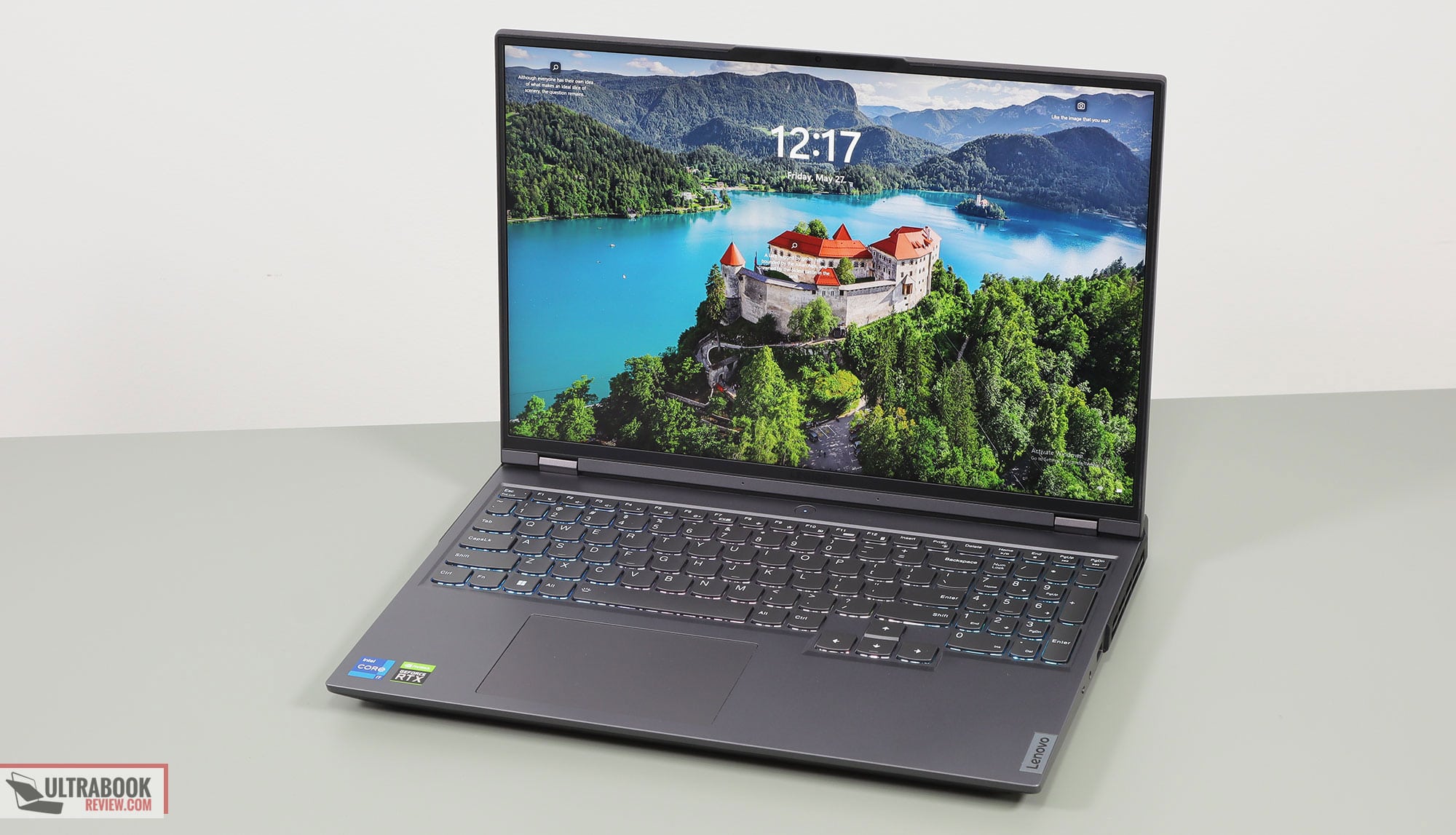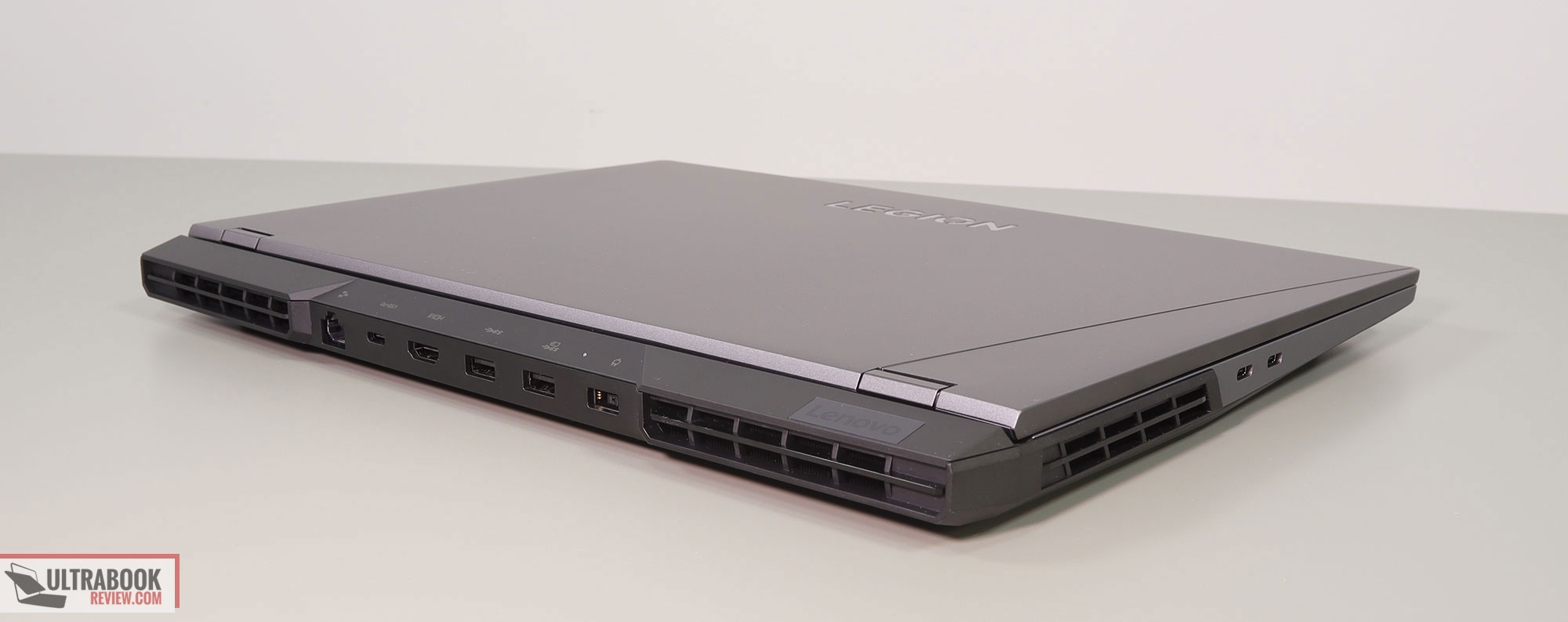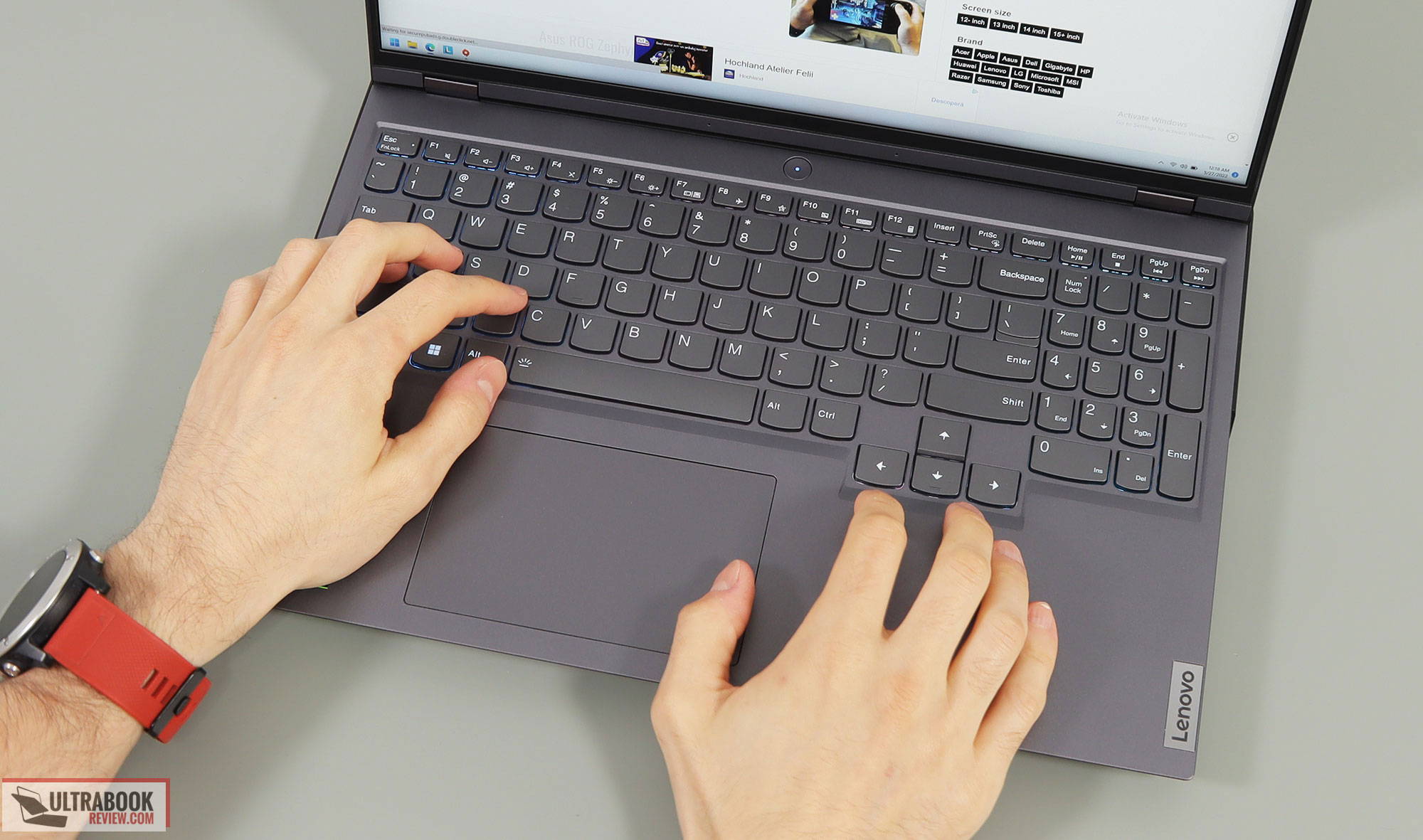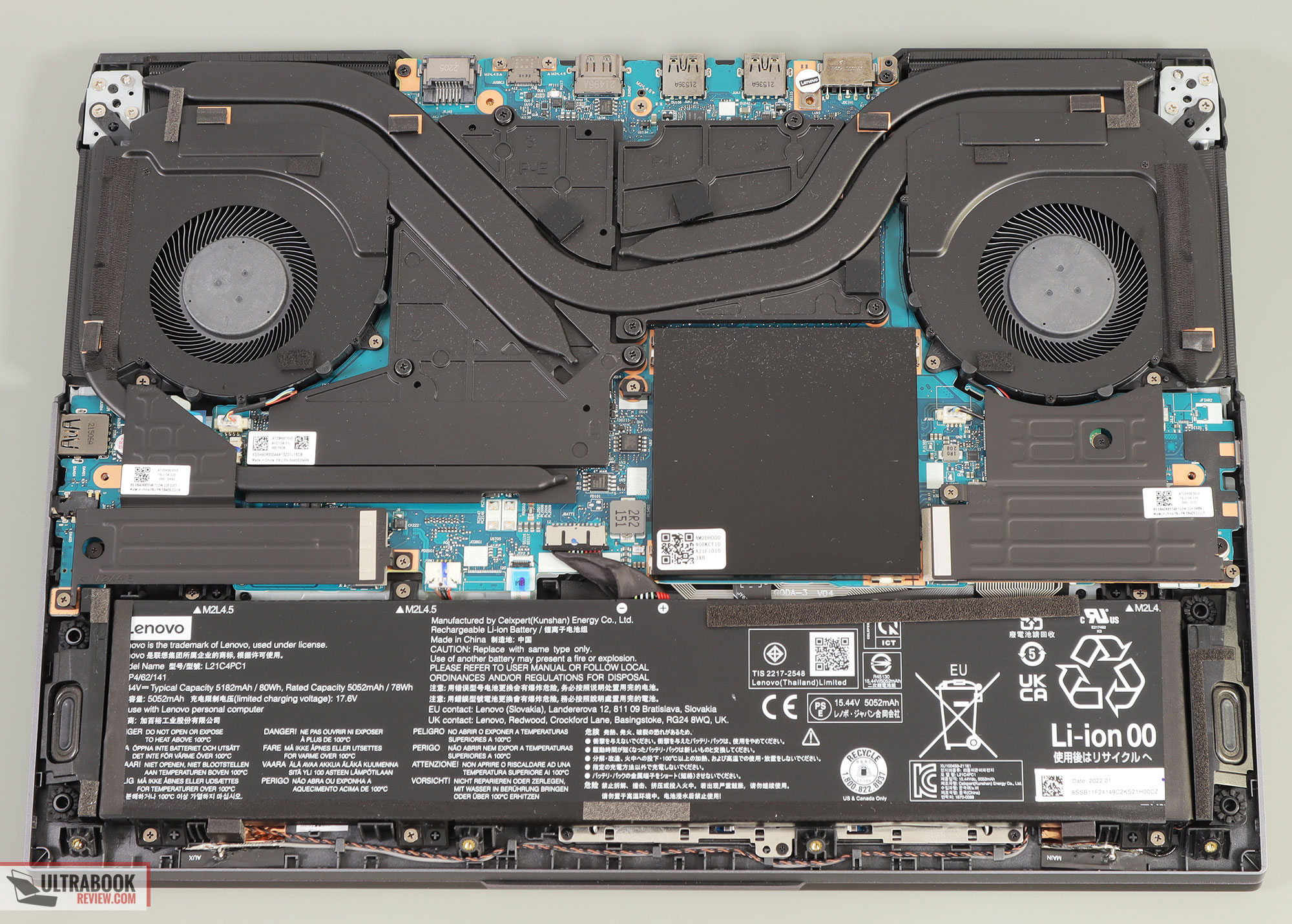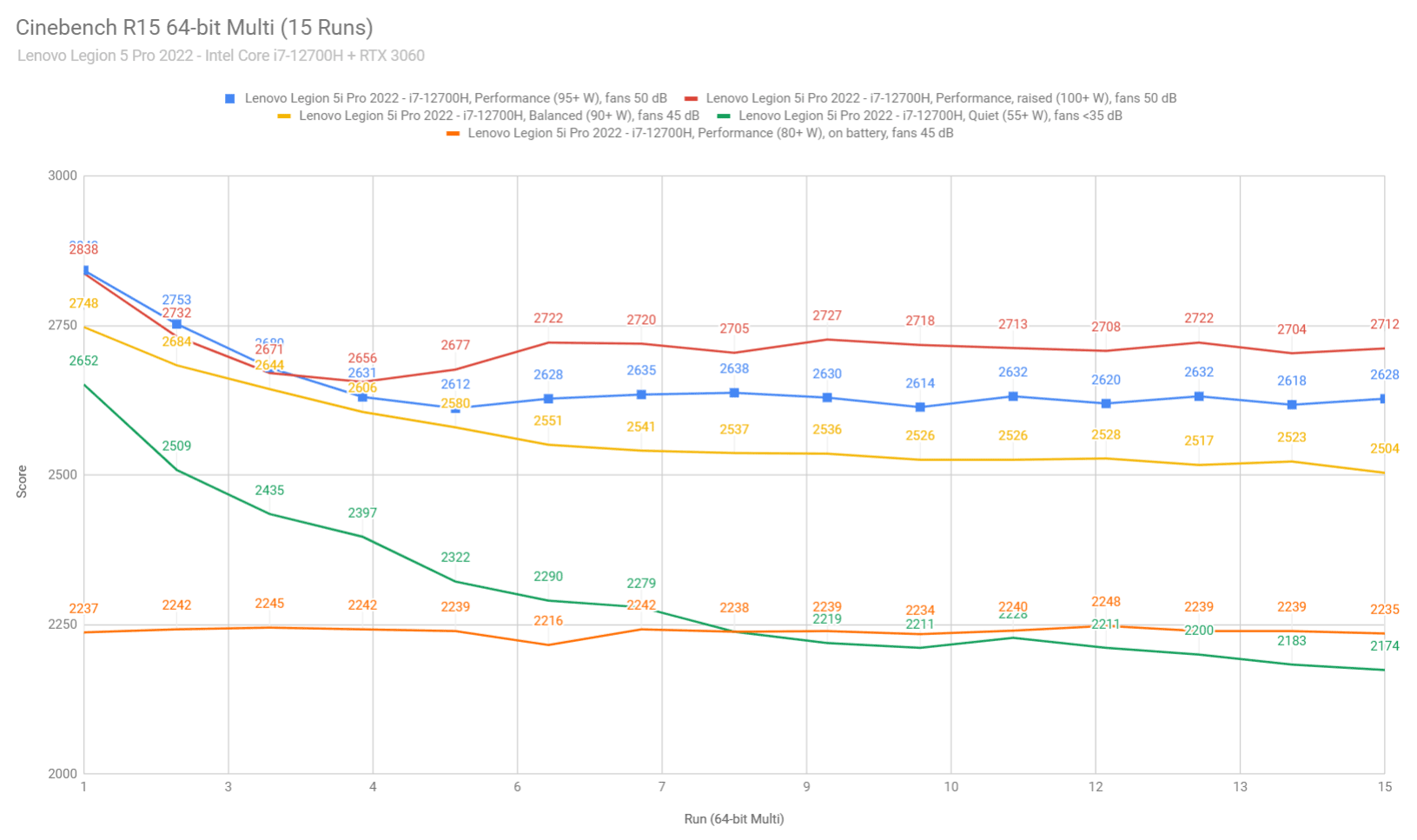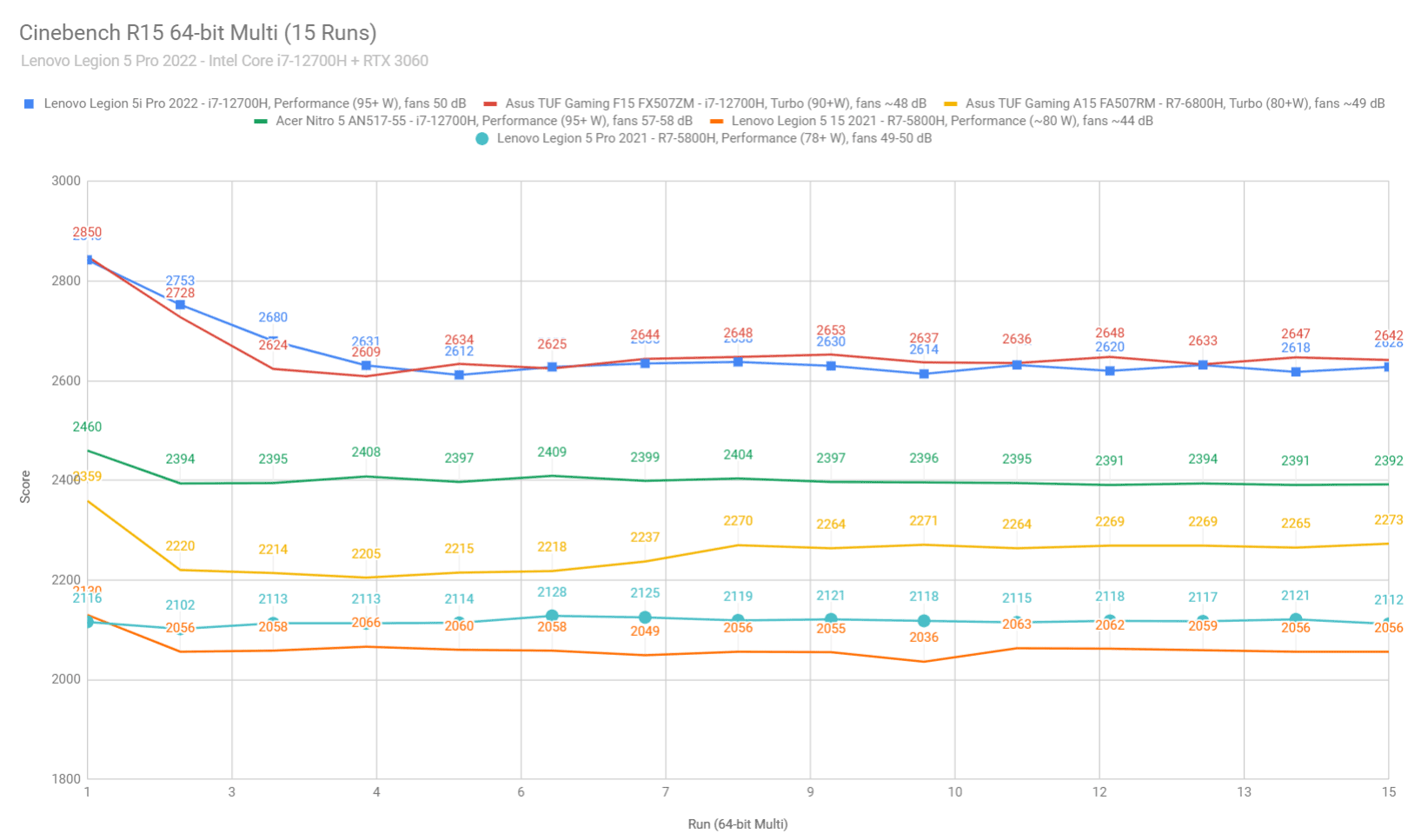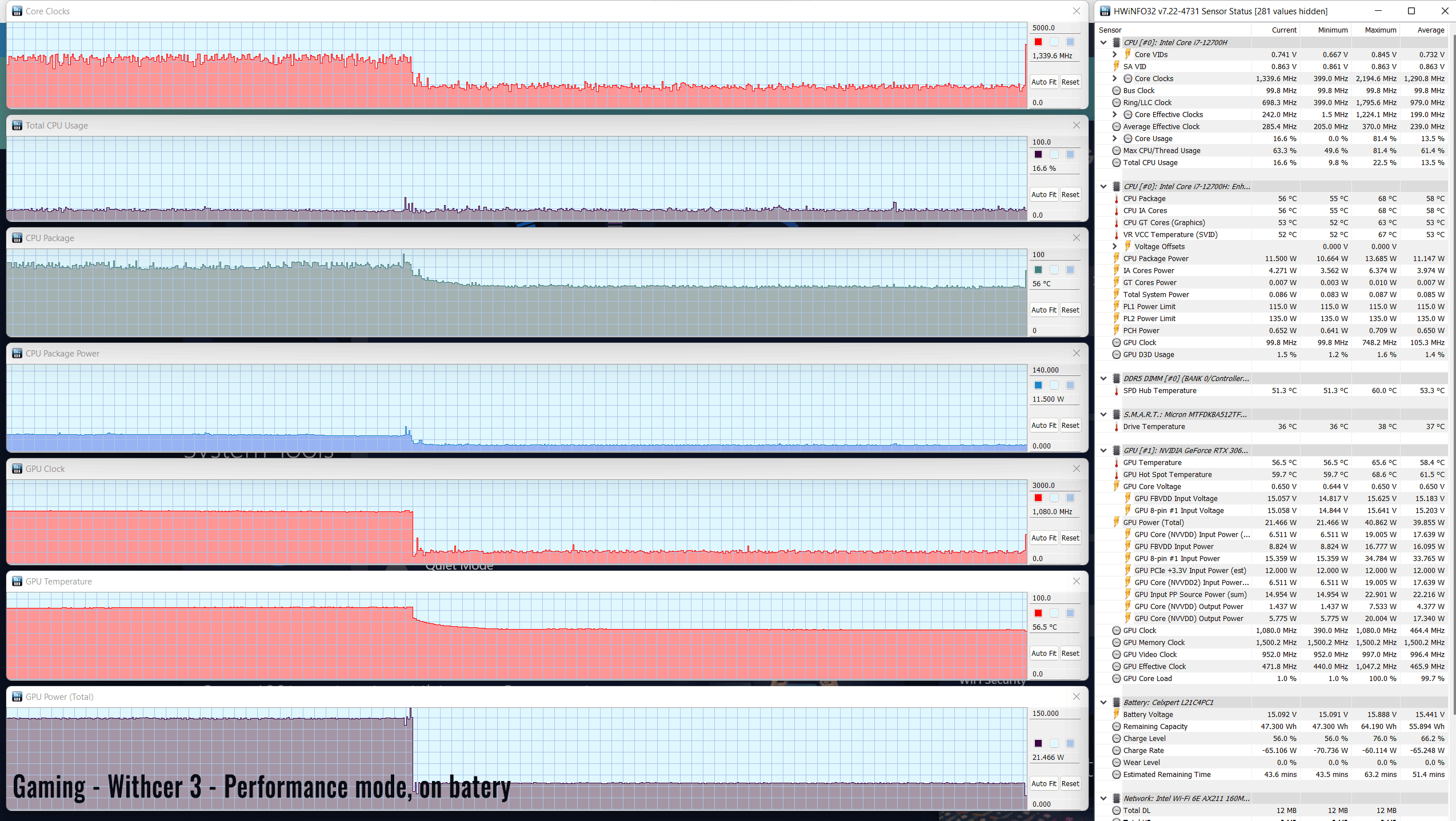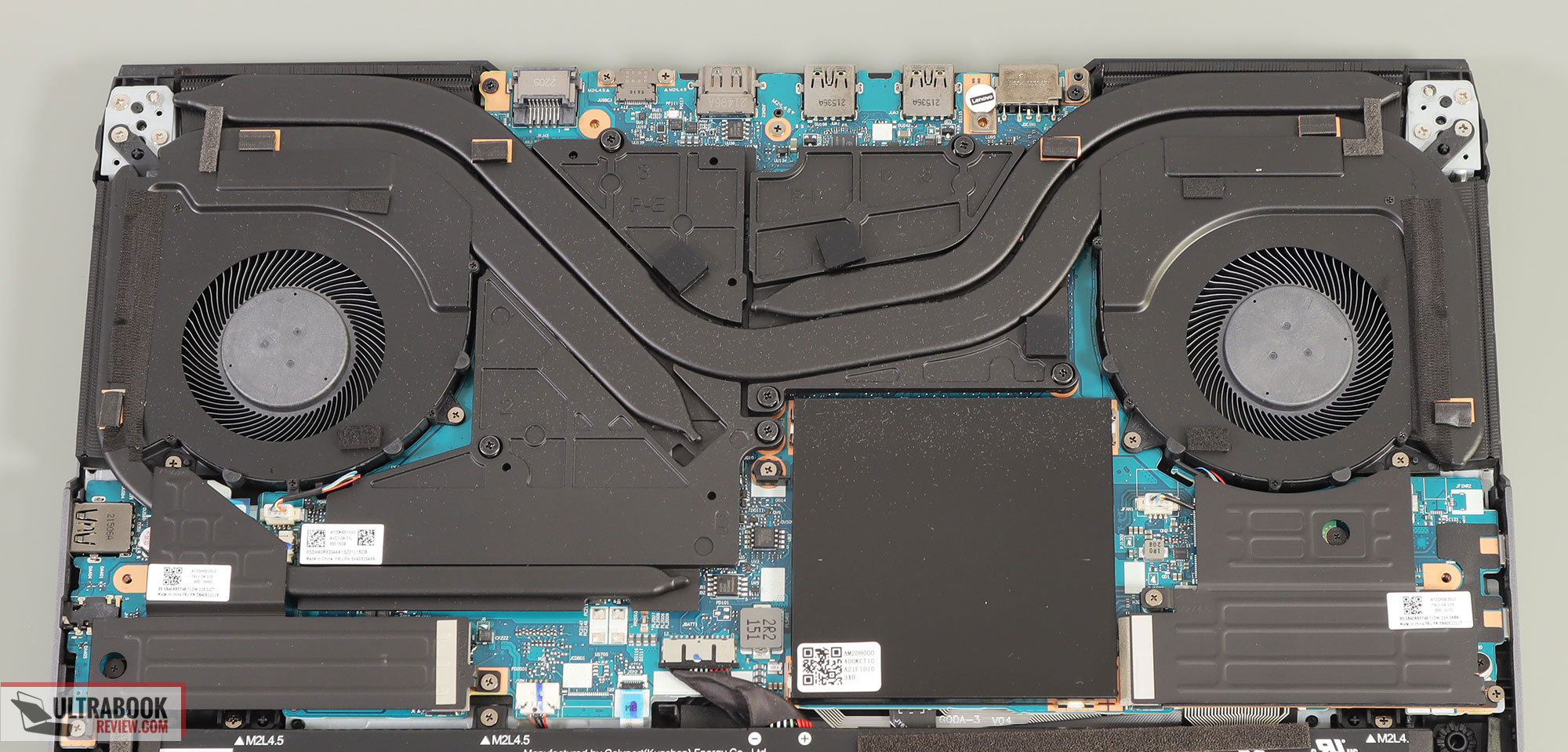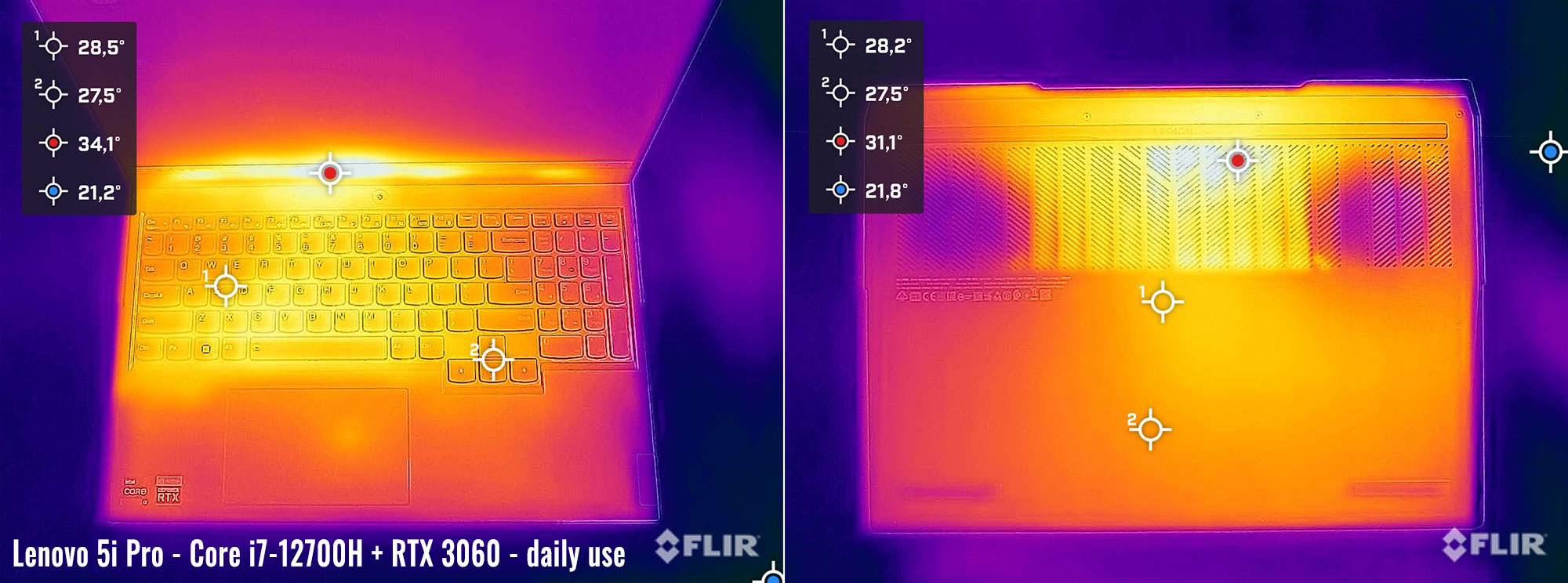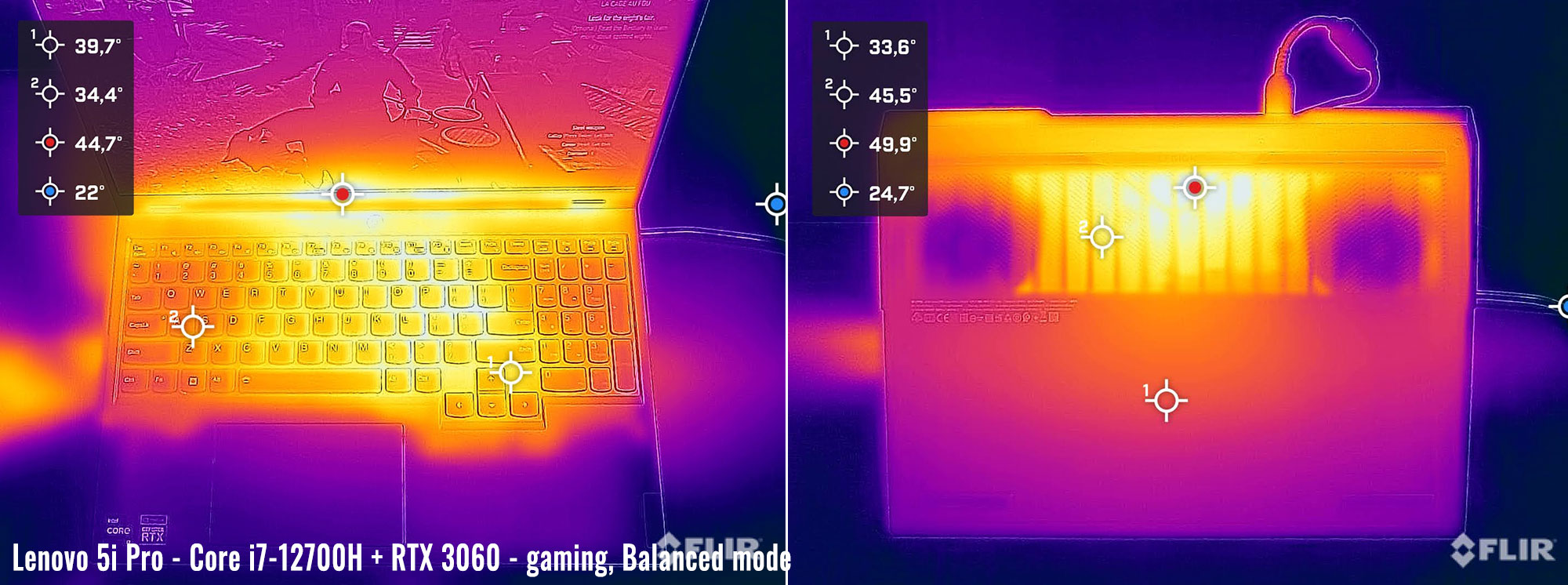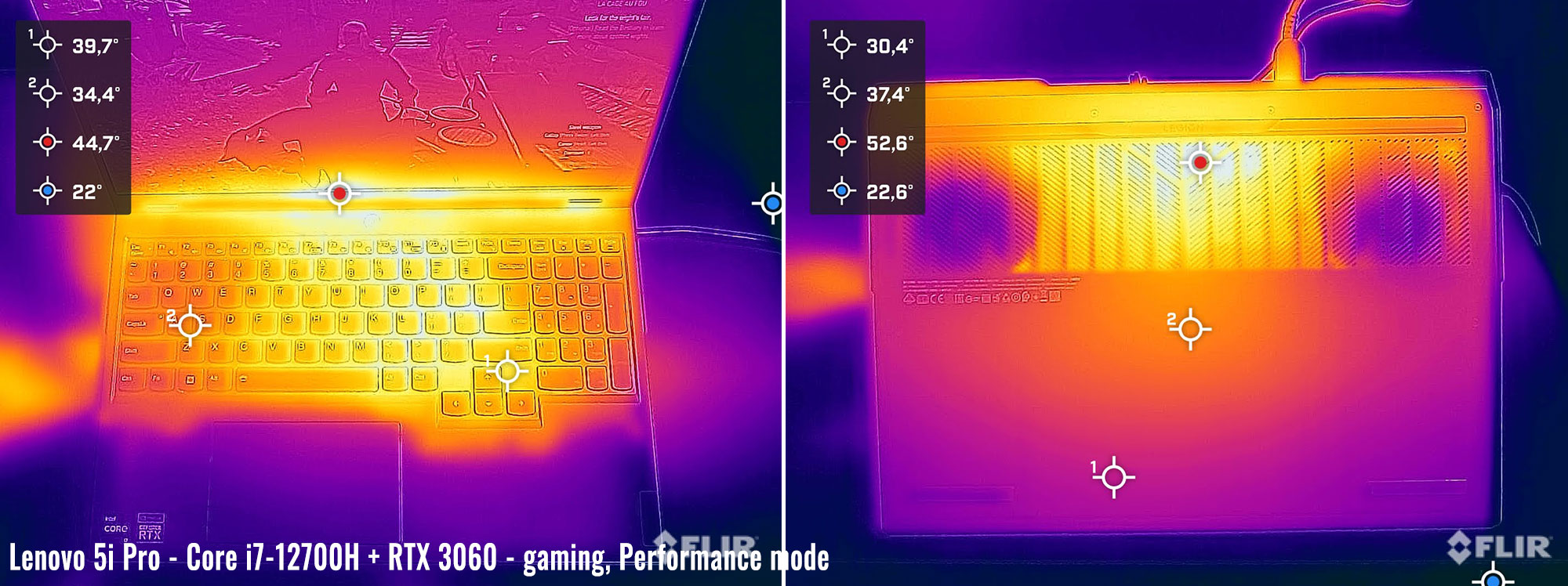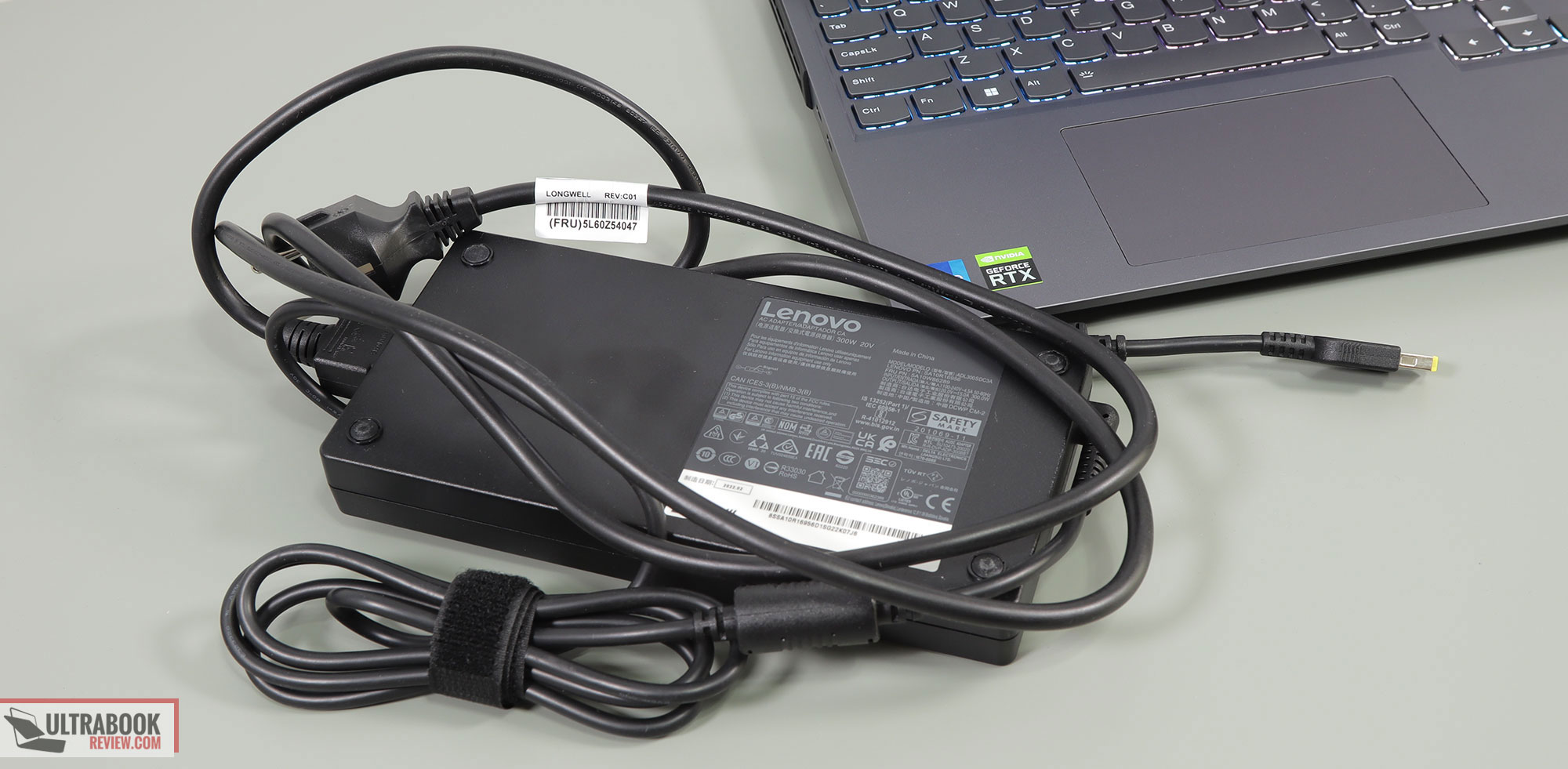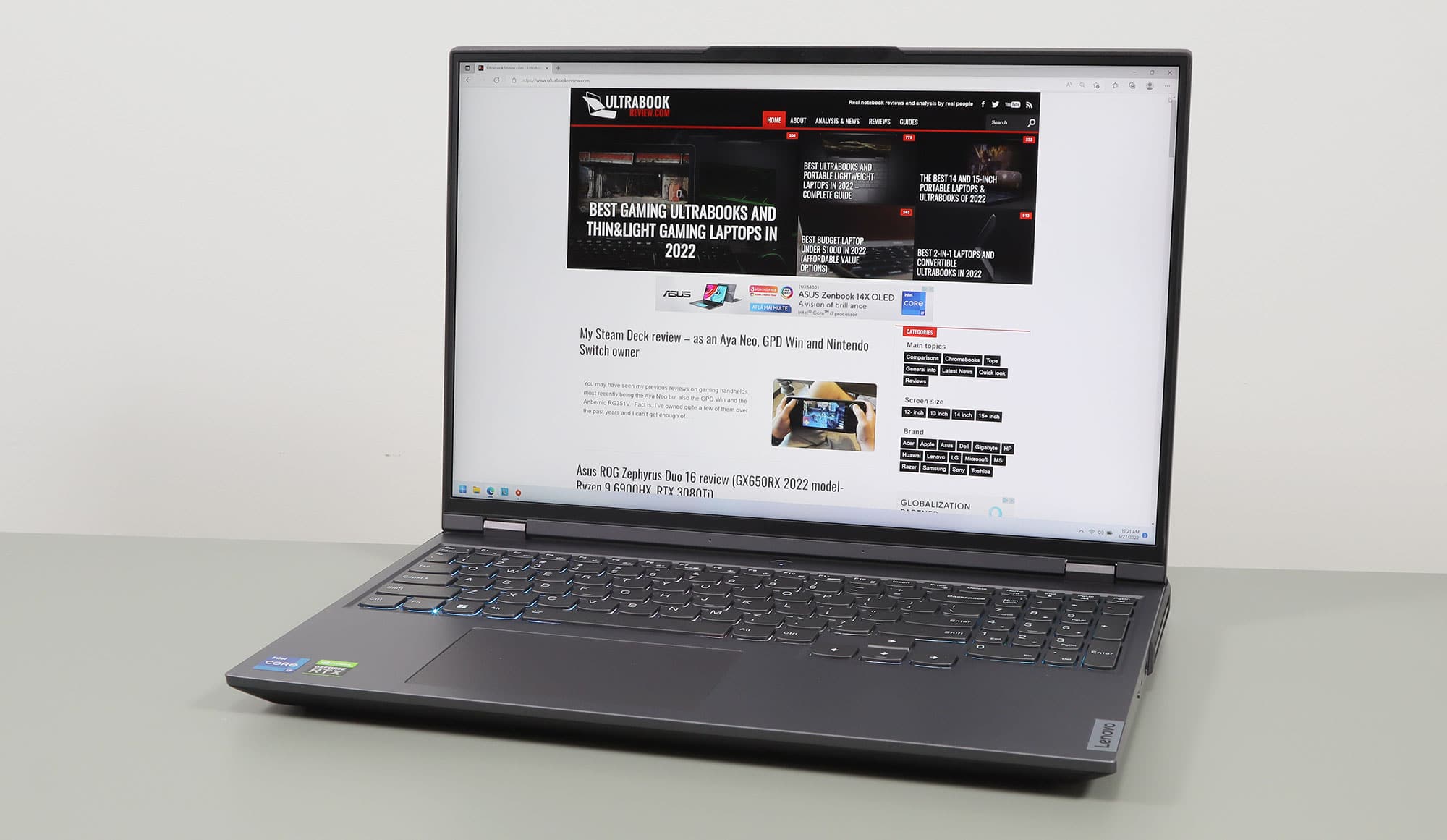
Lenovo Legion 5 Pro 2022 review (Legion 5i Pro model- Core i7-12700H, RTX 3060)
This is my detailed review of the 2022 Lenovo Legion 5 Pro series, in the 5i Pro variant built on an Intel 12th gen platform with Nvidia RTX 3000 graphics. And AMD-based 5 Pro model is also available, and we’ll cover it in a separate review.
The configuration I chose for this review bundles the Core i7-12700H processor with an RTX 3060 graphics chip, a mid-range option that should cater to most needs. The lineup can be specced up to an i9 processor and variations of RTX 3070/3080 dGPUs if you’re after superior graphics performance, with the expected increase in price. The majority of our findings in this review apply to all configurations, though.
Now, the 2022 Legion 5 Pro refreshes on what was one of my favorite mid-tier gaming laptops of the previous generation (here’s my review of the 2021 Legion 5 Pro). Externally, Lenovo redesigned the lid and the IO, while keeping most of the other aspects unchanged. Internally, though, they’ve transitioned to a powerful Intel processor, updated the GPU’s power settings and tweaked the power profiles, plus slightly improved the thermal module in order to cope with the higher-power hardware.
Are these enough for the 2022 Legion 5 Pro series to maintain its excellent value within its competitive niche? Mostly, yes, and I’ll explain why in the review down below, as well as go over the quirks that you should consider in your decision, especially when it comes to this Intel-based 5i Pro variant.
Specs as reviewed– 2022 Lenovo Legion 5i Pro
| Lenovo Legion 5i Pro 16ACH7H 2022 | |
| Screen | 16 inch, 2560×1600 px, IPS, 165 Hz, matte, 3ms |
| Processor | Intel 12th-gen Alder Lake, Core i7-12700H, 6PC + 8 Ec/24T |
| Video | Iris Xe + NVIDIA GeForce RTX 3060 with 6GB GDDR6 VRAM 115-140W, with MUX, Optimus, and GSync |
| Memory | 16 GB DDR5-4800 (2x 8GB DIMMS) – 2x DIMMs |
| Storage | 512 GB M.2 gen4 NVMe (Micron 3400) – 2x M.2 2280 PCIe gen4 SSD slots |
| Connectivity | WiFi 6E (Intel AX211), Bluetooth 5.2, Gigabit LAN (Realtek RTL8168/8111) |
| Ports | Left: 1x USB-C 3.2 gen2, 1x USB-C 4.0 with Thunderbolt 4 (on Intel only, 3.2 gen2 on AMD) Right: 1x USB-A 3.2 gen1, 1x audio jack, 1x eShutter button Back: LAN, 1x USB-C gen2 with DP, power up to 135W; 1x USB-A 3.2 gen2, 1x USB-A gen1, HDMI 2.1, DC-In |
| Battery | 80 Whr, 300 W charger, USB-C charging up to 135W |
| Size | 356 mm or 14.01” (w) x 264.2 mm or 10.4” (d) x 21.7-26.85 mm or .86-1.1” (h) |
| Weight | 2.53 kg (5.57 lbs),+ 1.15 kg (2.54 lbs) for the charger+cables, EU version |
| Extras | 4-zone RGB backlit keyboard, HD webcam with E-shutter kill switch, stereo bottom speakers |
You can find this in stores in multiple variants, going up to Core i9-12900H and RTX 3070/3070Ti 150W configurations. Lenovo also mentioned 3080-class specs back when the 5 Pros were unveiled, but I’m not seeing those available anywhere yet.
Furthermore, a QHD+ screen options with VRR support and up to 240 Hz refresh rate was touted for the series, but it’s not yet available.
Design and construction
Much like in the past, Lenovo offers the Legion 5 Pro series in two color variants, this dark-gray model that we have here, and a white option with a gray back hump. I was a bit skeptical about a white gaming laptop in the past, but having experienced the white 2021 Legion 5 Pro in the past, I can see why some of you will appreciate its appeal and uniqueness factor.
In comparison, this silver model looks a bit bland to me. It is, however, one of the most practical and sturdily built designs you’ll find in this class, with almost no flex in the chassis or the lid, and surfaces that are excellent at hiding away smudges and fingerprints. Furthermore, this is entirely built out of aluminum and magnesium alloys, and everything feels better quality than you’d perhaps expect from a mid-range notebook.
I also appreciate that Lenovo have slightly redesigned this year’s Legion 5 Pro model, with the notable changes being on the lid. Gone is the backlit Y logo of the past, which was replaced with a more professional-looking LEGION branding, similar to the Legion 5 and Legion 7 models. In fact, the entire design of this 2022 update is now minimalist and professional, so perfect for even the stricter business/school environments.
The other slight changes are in the IO layout, where the headphone jack was moved to the right side and two USB-C ports were added to the left, while everything else is still tucked away on the back edge, behind the screen.
The USB-C on the back is the only one that supports PD charging at up to 135W. This also gets data (10Gbps – USB 3,2 gen2 speeds) and video (through a dGPU connection). The USB-Cs on the left edge are both data and video capabilities, with the one closer to the front laptop being USB-C 3.2 (10 Gb, dGPU connection), and the other one being Thunderbolt 4 capable (40 Gb, iGPU connection). I appreciate having all these options to choose from.
However, I’m not that happy with the audio jack moved on the right, though, I preffer not to have any cables around my mouse area. Plus, there’s still no SD card reader on this design, which I feel would make a lot of sense for potential creators.
My other nits with this series are the always-on light in the power button, which at least is faint and changes color based on the selected power profile, so is somewhat useful. There’s little excuse for the limited screen angle, though, which only goes back to about 130 degrees. That’s fine as long as you’re using the laptop on a desk, but limiting on the lap and in other situations.
That aside, this is a good and practical notebook. The rubber feet provide excellent grip on the desk, the screen can be easily picked up and adjusted with a single hand, and most of the lips and corners are friendly on the wrists.
You should, however, keep in mind that this is a full-size and rather heavy laptop, at nearly 2.55 kilos for this configuration, plus 1.2 kilos extra for the chunky 300W charger that comes included even with this RTX 3060 configuration (and everything above). So, if you’re after something portable to lug around every day, this might not be it.
Keyboard and trackpad
The keyboard and clickpad haven’t changed from the previous Legion 5 Pro models, except for the fact that Lenovo color-matched the keycaps on this 2022 grey variant with the chassis design. Previously, the grey 5 Pro came with black keycaps. The white variant still comes with white keycaps.
The layout is still among the best you’ll find in a mid-range laptop these days. The main set of keys are full-size, the arrows are also all full-size keys and spaced out from everything around, and there’s also a NumPad section, with slightly narrower keys, but still perfectly usable.
This is a also very good typer, even if perhaps a tad shallower than what other OEMs put in their gaming laptops, with actuations that require a softer stroke. In a way, this keyboard feels a lot closer to what Lenovo offer with their IdeaPad and Yoga ultraportables. I appreciate this kind of feedback, but some of you might not. I also appreciate how quietly this types, even if the Space key is more audible than the others.
For the lighting, what you’re getting here are RGB LEDs with 4-zone control. They’re bright and uniform, but at the same time plenty of light bleeds out from under the keycaps with this design. Plus, I couldn’t figure out a setting that would allow the lighting to automatically switch off after 30 seconds, so I had to always disable it manually by hitting FN + Space (which cycles between a couple of modes, one of them being the LEDs switched off).
For mouse, the 5 Pro gets a mid-sized clickpad. The surface is plastic, as Lenovo are only offering glass clickpads on the Legion 7 models, but it feels alright to the touch and works well.
Still, the clickpad is centered on the Space key with this design, and thus shifted towards the left side of the chassis. This might take some time to get used to, especially if you’re coming from a centered design.
It might also cause some fake palm swipes for you, with your left palm swiping over the surface. I haven’t noticed any fake swipes during my time with this unit, but Derek mentioned them during his time with his 2021 Legion 5 Pro laptop, and explained here how you can address them if needed.
As for biometrics, there are still none on this series.
Screen
Much like before, Lenovo offers a 16-inch 16:10 WQHD IPS matte screen on the 2022 Legion 5 Pro series, but the panel has been slightly updated from the 2021 model.
In fact, there are two panel options for the 2022 5i Pro, the standard QHD+ 165 Hz option that we have here, and an upgraded panel that goes up to 240 Hz and supports VRR – variable refresh rate, which is also offered with the 2022 Legion 7 models. That one is not yet available at this time.
So back to the default QHD+ 165Hz panel, it offers 500+ nits of brightness, almost 1300:1 contrast, and almost 100% sRGB color coverage, which is perfectly adequate for everyday use, even in brighter offices or outdoors. The taller 16:10 format allows for an increased workspace area, but at the same time, the blacks get washed out at maximum brightness and the colors are only standard gamut, which might limit this for specific creators and professionals.
Despite that, colors appear punchy on this panel, especially when you pump up the brightness. For professional color-accurate use, this panel is not at the level of the 500-nits 100% DCI-P3 panel available in devices such as the ROG Zephyrus M16 reviewed here (and probably others), but it is otherwise an excellent option for daily uss.
This panel is also well suited for gaming, with a 165 Hz refresh rate and fast response times. This laptop also offers a MUX and ActiveSync/GSync support between the Hybrid/dGPU available modes. We’ll get in-depth on these in the next section of this review.
Here’s what we got in our tests, with an X-Rite i1 Display Pro sensor:
- Panel HardwareID: BOE BOE0A1F (NE160QDM-NY1);
- Coverage: 97.0% sRGB, 71.6% DCI-P3, 73.8% AdobeRGB;
- Measured gamma: 2.17;
- Max brightness in the middle of the screen: 534.94 cd/m2 on power;
- Min brightness in the middle of the screen: 7.237 cd/m2 on power;
- Contrast at max brightness: 1278:1;
- White point: 6100 K;
- Black on max brightness: 0.41 cd/m2;
- PWM: No;
- Response: ~7.5ms GtG (source).
Our sample came out somewhat poorly calibrated out of the box, with a skewed Gamma and White point.
However, even after calibration, our tests are showing significant DeltaE imbalances in the entire top and right third part of this screen. They are even visible to the naked eye with shades of Reds and Yellows, with the right side being desaturated in comparison to the rest of the panel. Take these findings with a grain of salt, as I haven’t seen anything similar with the previous Legion 5 pro/7 models we’ve reviewed, but expect variations between these panels – that being the case, I do advise testing for any issues or imbalances once you get your unit, especially if you plan to edit photos/videos on it.
I’ll also mention that the Fn+R shortcut doesn’t do anything on this laptop. It was supposed to change between 60 and 165 Hz screen refresh rates, helping to extend runtimes on battery use, but it just doesn’t work here. Instead, you need to go and change the refresh manually in the settings. I’ve run into similar issues on some Legion laptops in the past, and I would have hoped Lenovo figured it out by now, but they didn’t.
One final
Hardware and performance
Our test model is a mid-specced configuration of the 2022 Lenovo Legion 5i Pro, built on an Intel Core i7-12700H processor, 16 GB of DDR5-4800 memory in dual channel, 512 GB of middling SSD storage, and dual graphics: the Nvidia RTX 3060 dGPU with 6 GB of vRAM and the Iris Xe iGPU integrated within the Intel processor.
Disclaimer: This is a retail unit provided for this review by Lenovo, and it runs on the software available as of mid-May 2022 (BIOS J2CN37WW, Vantage 3.12.13.0, GeForce 512.77 drivers). This is a mature software package, as the laptop has been available in stores for a few months now, but some aspects might still change with later updates.
Spec-wise, this 2022 Legion 5i Pro is built on the latest Intel and Nvidia hardware available to date. The Core i7-12700H is the mainstream performance option in Intel’s Alder Lake 12th-gen platform, with 14 Cores and 20 Threads. It is a hybrid design with 6 High-Performance and dual-threaded Cores, and 8 extra Efficiency cores, which work together in the various loads. The design and thermal module of this Legion allow the processor to run at 100+W of sustained power in demanding CPU loads.
For the GPU, the 2022 Legion 5i Pro series is available with RTX 3000 and RTX 3000 Ti graphics chips. What we have on this sample is the entry-tier RTX 3060 running at up to 140W with Dynamic Boost in supported games and applications. In comparison, the 2021 Legion 5 Pros allowed up to 130W of GPU power.
A MUX is still offered here, but no Advanced Optimus. This means you can opt for a Hybrid mode that enables Optimus (in the Vantage control app or in the BIOS ), which actively switches between the Vega and Nvidia chips, or disable the Hybrid mode and only keep the Nvidia dGPU active, which directly links the dGPU to the internal display and also enables GSync in the settings. Switching between these modes requires a restart.
For the RAM and storage options, the laptop still comes with two accessible memory DIMMs and two M.2 SSD slots. Our unit is a 16 GB of DDR5-4800 RAM configuration, with a middling PCIe 4.0 Micron 3400 SSD.
Getting to the components requires you to remove a few Philips screws, all visible around the back, and then pull up the D-panel. Use a plastic pin and work your way slowly starting from the front lip and then around the air grills on the sides – you’ll struggle here, because the caps are snug and you’ll have to pull hard. Inside, the RAM and SSDs are covered by radiator shields, so you’ll have to take those out as well to get to the components. Overall, upgrades are possible here, but the process is a bit more complicated than it should.
For the software, I put a fresh Windows 11 copy on this review unit and then installed the Lenovo Vantage app that took care of all the other updates. This way, I didn’t get any of the bloatware that comes preinstalled with Lenovo laptops these days.
The power profiles are Quiet, Balanced, and Performance, and you can select them from Vantage or switch between them with Fn+Q. Performance is only available with the laptop plugged into the wall. These profiles apply different power settings to the CPU/GPU and different fan profiles, as well as switch the color of the LED in the power button. Here’s a table that shows what each mode does:
| Quiet (blue) |
Balanced (white) |
Performance (red) |
|||
| TDP PL1/PL2 | TGP | TDP PL1/PL2 | TGP | TDP PL1/PL2 | TGP |
| 115/135W | ~40W | 115W/135W | ~95W | 115W/135W | ~135W |
The settings are quite a lot different than on the 2021 Legion 5 Pro reviewed a while ago. Lenovo set hard power limits for the GPU between modes, but not for the CPU. Instead, the modes affect the fans’ rpms, and forces the processor to run at the best of its abilities within a 95 degrees Celsius thermal limit. Hence, the CPU is thermally limited to a lesser or greater degree between the three modes. We’ll get in-depth on this further down.
There’s an option to overclock the GPU in the BIOS/Vantage on this model. By default, it applies a +100 MHz Clock, +200 MHz Memory overclock, but you can further tweak it.
Before we jump to the performance section, here’s how this laptop handles everyday use and multitasking on the Quiet/Balanced profiles, unplugged from the wall. We tested the laptop with the screen set at either 60Hz or 165 Hz, to document the power draw differences between the two modes.
Performance and benchmarks
On to more demanding loads, we start by testing the CPU’s performance by running the Cinebench R15 test for 15+ times in a loop, with a 1-2 seconds delay between each run.
The Core i7-12700H processor stabilizes at ~95W of sustained power on the Performance setting, with the laptop sitting on the desk. As mentioned earlier, Lenovo applies 115W PL2 and 135W PL1 power limits for this processor on all power modes, and the CPU is then thermally throttled based on how fast the fans spin.
For this scenario, the fans ramp up to 50 dB at head level, and the CPU thermally and power throttles around the 97+ C limit, stabilizing at around 95W of power.
Bumping the back of the laptop off the desk in order to improve the airflow into the fans allows the processor to stabilize at a higher sustained power of 100+W, with similar 50 dB noise levels, and a slight increase in the Cinebench scores. This implies that the fans are somewhat choked on this design with the laptop sitting on the desk. More on this in a bit.
Switching over to the Balanced profile translates in the CPU stabilizing at ~90W, with the same kind of thermal and power throttling. However, the fans spin at around 45 dB noise levels in this mode, hence the lower sustained power.
On the Quiet profile, the CPU gradually drops in power towards 55-60W, with quiet fans at sub 35 dB and similar 97+ C temperatures.
Finally, the CPU runs at ~80 W on battery, on the Performance profile, with stabilized scores of around 2200 points. That’s excellent performance for battery use, but don’t expect more than one hour of such runtime. Details below.
Overall, I’m not happy with this approach that runs the CPU at 97+ C in sustained loads. I can understand it for the Performance mode, but for the other profiles, Lenovo should have implemented hard power limits and prevented that kind of hot CPU temperatures.
They have set power limits on the past Lenovo Legions laptops that we’ve reviewed, so I’m not entirely sure what’s what with this generation. Perhaps the fact that my unit runs a fresh Windows 11 install and not something pre-loaded from the factory might impact the behaviour, although that wouldn’t be an excuse. I’m curious if your units are performing any differently, so please let me know in the comments section down below.
Anyway, to put these findings in perspective, here’s how this Core i7-12700H implementation fares against other mid-tier laptops in this test, both Intel and AMD. No surprise, the i7 runs excellently in this laptop, on par or faster than other similar power implementations. Furthermore, you should expect this Intel configuration to score about 15% higher in this test than the AMD Ryzen 7 6800H models of the same generation, and 20-25% higher than the 2021 AMD models, which ran at slightly lower power settings.
We then went ahead and further verified our findings with the more taxing Cinebench R23 loop test and Blender – Classroom, which resulted in similar findings to what we explained above, and only a slightly lower sustained CPU power in the Quiet mode, as a result of heat building-up with the slow-spinning fans in this case.
We also ran the 3DMark CPU test on the Performance and Balanced profiles. There’s hardly any difference, given how the power settings are designed for the two modes.
Finally, we ran our combined CPU+GPU stress tests on this notebook. 3DMark stress runs the same test for 20 times in a loop and looks for performance variation and degradation over time, and this unit passed it just fine, which means there’s no performance throttling with longer-duration sustained loads.
Next, we ran the entire suite of tests and benchmarks, on the Performance profile in Vantage, the MUX set on Hybrid mode, GPU Ovberclock switched ON, and on FHD screen resolution for consistency with our other tests. Here’s what we got:
- 3DMark 13 – Fire Strike: 21557 (Graphics – 23487, Physics – 28771, Combined – 10821);
- 3DMark 13 – Port Royal: 5365;
- 3DMark 13 – Time Spy: 9600 (Graphics – 9225, CPU – 12479);
- Uniengine Superposition – 1080p Extreme: 5729;
- Uniengine Superposition – 1080p Medium: 16882;
- Handbrake 1.3.3 (4K to 1080p encode): 63.27 average fps;
- PassMark 10: Rating: 5656 (CPU: 30997, 3D Graphics: 16009, Memory: 2839, Disk Mark: 35258);
- PCMark 10: 7153 (Essentials – 10121, Productivity – 9208, Digital Content Creation – 10659);
- GeekBench 5.4.3 64-bit: Single-Core: 1765, Multi-core: 12614;
- CineBench R15 (best run): CPU 2872 cb, CPU Single Core 261 cb;
- CineBench R20 (best run): CPU 7022 cb, CPU Single Core 694 cb;
- CineBench R23: CPU 17940 cb (best single run), CPU 17339 cb (10 min run), CPU Single Core 1805 cb;
- x265 HD Benchmark 64-bit: 24.30 s.
And here are some workstation benchmarks, on the same Performance profile:
- Blender 3.01 – BMW scene – CPU Compute: 2m 16s (Performance);
- Blender 3.01 – BMW scene – GPU Compute: 25s (CUDA), 14s (Optix);
- Blender 3.01 – Classroom scene – CPU Compute: 5m 19s (Performance);
- Blender 3.01 – Classroom scene – GPU Compute: 50s (CUDA), 28s (Optix);
- Pugetbench – DaVinvi Resolve: 1087;
- Pugetbench – Adobe Afert Effects: 916;
- Pugetbench – Adobe Photoshop: 964;
- Pugetbench – Adobe Premiere: 985;
- SPECviewperf 2020 – 3DSMax: 89.09 (Performance);
- SPECviewperf 2020 – Catia: 55.8 (Performance);
- SPECviewperf 2020 – Creo: 91.33 (Performance);
- SPECviewperf 2020 – Energy: 22.35 (Performance);
- SPECviewperf 2020 – Maya: 282.42 (Performance);
- SPECviewperf 2020 – Medical: 28.45 (Performance);
- SPECviewperf 2020 – SNX: 17.56 (Performance);
- SPECviewperf 2020 – SW: 191.05 (Performance).
- V-Ray Benchmark: CPU – 11977 vsamples, GPU CUDA – 953 vpaths, GPU RTX – 1274;
This laptop performs pretty mostly on par with the similarly specced i7 + RTX 3060 140W configuration of the Asus TUF Gaming F15, although the TUFmanages to outscore it by a minimal 2-5% in CPU loads such as Cinebench R23 and Geekbench. Long-term CPU and combined CPU+GPU performance are nearly identical between the two.
Now, compared to the Ryzen 7 + RTX 3060 140W of the TUF Gaming A15 series, this Intel-based Legion 5i Pro wins by a 10-20% margin in the CPU tests, and by up to 5% in GPU loads. These differences are indicative of what you should expect from the AMD-based Legion 5 Pro 2022 update.
Finally, compared to the Ryzen 7 + RTX 3060 130W of the 2021 Legion 5 pro series, this 2022 Legion 5i Pro is up to 25% faster in CPU loads and 5% faster in the GPU loads.
In conclusion, the major update with this series is the overall performance of the 12th gen Intel platform. This will make a difference in CPU-intensive tasks, both in single-threaded activities such as Photoshop, Creo, or After Effects, but also in multi-threaded loads such as Blender, V-RAY, 3DSMax, or Davinci Resolve. Furthermore, applications that support Quick Sync, such as Premiere, further benefit on this Intel configuration.
With that out of the way, some of you might not appreciate the loudly spinning fans on the Performance mode, which ramp up to 50 dB at head-level. Thus, if you prefer sacrificing the performance to some extent for quieter fan noise, here’s how this Legion 5i Pro does on the Balanced profile, which limits the fans to somewhere around 45 dB at head level.
- 3DMark 13 – Fire Strike: 18479 (Graphics – 19981, Physics – 27688, Combined – 8960);
- 3DMark 13 – Time Spy: 8399 (Graphics – 7923, CPU – 12743);
- Uniengine Superposition – 1080p Extreme: 12524;
- GeekBench 5.4.3 64-bit: Single-Core: 1781, Multi-core: 12753;
- CineBench R20 (best run): CPU 6721 cb, CPU Single Core 659 CB;
- x265 HD Benchmark 64-bit: 25.05 s;
- Blender 3.01 – Classroom scene – CPU Compute: 5m 39s (Balanced).
The CPU performance is hardly impacted even in the longer-duration loads, as explained earlier in this review in the Cinebench loop test. However, the GPU is power limited in this mode and eds-up performing at about 75-80% of its capabilities in Performance mode. Up to you if the tradeoff is worth it.
For what is worth, the components and especially the GPU run at lower internal temperatures on this Balanced mode than on performance, and that should make the Balanced profile even more attractive for longer work/gaming sessions.
Gaming performance
Let’s look at some games.
We tested a couple of different types of games on the Performance, Balanced and Quiet modes, all with the MUX set on the discrete GPU mode and the applied GPU default overclock (+100 MHz Core, +200 Mhz Memory).
| Core i7-12700H + RTX 3060 Laptop 90-125W |
QHD+ Performance | QHD Performance | QHD+ Balanced | FHD+ Performance | FHD+ Quiet |
| Battlefield V (DX 12, Ultra Preset, RTX OFF) |
100 fps (59 fps – 1% low) | 108 fps (63 fps – 1% low) | 88 fps (46 fps – 1% low) | 134 fps (65 fps – 1% low) | 38 fps (31 fps – 1% low) |
| Cyberpunk 2077 (DX 12, Ultra Preset, RTX OFF) |
35 fps (27 fps – 1% low) | 37 fps (30 fps – 1% low) | 31 fps (22 fps – 1% low) | 53 fps (44 fps – 1% low) | – |
| Doom Eternal (Vulkan, Ultra Preset) |
insufficient vRAM | insufficient vRAM | – | 216 fps (144 fps – 1% low) | – |
| Far Cry 6 (DX 12, Ultra Preset, TAA) |
67 fps (39 fps – 1% low) | 71 fps (43 fps – 1% low) | 61 fps (35 fps – 1% low) | 88 fps (48 fps – 1% low) | 26 fps (18 fps – 1% low) |
| Far Cry 5 (DX 11, Ultra Preset, SMAA) |
crashed | crashed | crashed | 127 fps (87 fps – 1% low) | – |
| Metro Exodus (DX 12, Ultra Preset, RTX OFF) |
52 fps (31 fps – 1% low) | – | – | 66 fps (41 fps – 1% low) | – |
| Red Dead Redemption 2 (DX 12, Ultra Optimized, TAA) |
70 fps (48 fps – 1% low) | 74 fps (50 fps – 1% low) | – | 96 fps (63 fps – 1% low) | – |
| Shadow of Tomb Raider (DX 12, Highest Preset, TAA) |
74 fps (54 fps – 1% low) | 80 fps (56 fps – 1% low) | 65 fps (56 fps – 1% low) | 111 fps (68 fps – 1% low) | 33 fps (27 fps – 1% low) |
| The Witcher 3: Wild Hunt (DX 11, Ultra Preset, Hairworks On 4) |
82 fps (65 fps – 1% low) | 87 fps (71 fps – 1% low) | 74 fps (63 fps – 1% low) | 113 fps (89 fps – 1% low) | 35 fps (17 fps – 1% low) |
- Battlefield V, Cyberpunk, Doom, Witcher 3 – recorded with Fraps/in-game FPS counter in campaign mode;
- Far Cry 5, 6, Metro, Red Dead Redemption 2, Tomb Raider games – recorded with the included Benchmark utilities;
- Red Dead Redemption 2 Optimized profile based on these settings.
Those above are rasterization tests, and here are some results for RTX titles with and without DLSS.
| Core i7-12700H + RTX 3060 Laptop 90-125W |
QHD+ Performance | FHD+ Performance |
| Battlefield V (DX 12, Ultra Preset, RTX ON, DLSS OFF) |
50 fps (27 fps – 1% low) | 83 fps (48 fps – 1% low) |
| Battlefield V (DX 12, Ultra Preset, RTX ON, DLSS ON) |
64 fps (47 fps – 1% low) | 92 fps (77 fps – 1% low) |
| Cyberpunk 2077 (DX 12, Ultra Preset + RTX, DLSS Balanced) |
37 fps (25 fps – 1% low) | 51 fps (37 fps – 1% low) |
| Doom Eternal (DX 12, Ultra Preset, RTX ON, DLSS Quality) |
insufficient vRAM | insufficient vRAM |
| Far Cry 6 (DX 12, Ultra Preset + DXR reflections / shadows) |
insufficient vRAM | 63 fps (38 fps – 1% low) |
| Shadow of Tomb Raider (DX 12, Highest Preset, TAA, RTX Ultra) |
34 fps (26 fps – 1% low) | 54 fps (36 fps – 1% low) |
I ran into a couple of crashes and unexplainable throttled performance in some cases, such as in Doom Eternal or in Far Cry 5 and 6 running at QHD+ resolution. The same titles were running fine on other RTX 3060 laptops at a similar resolution, so I don’t know what’s causing the conflicts here.
These aside, though, the gaming performance is excellent here, on par with other high-power Intel 12th-gen + RTX 3060 implementations. At the same time, I’m looking at up to 10% higher framerates vs. the 2021 Ryzen 7 + RTX 3060 configuration of the Legion 5 Pro at QHD+ resolution, and a somewhat higher difference at FHD+ resolution. These differences vary between the tested titles, though.
With that out of the way, let’s go over some performance and temperature logs.
As mentioned earlier, the Performance mode ramps up to fans to loud levels of 49-50 dB with the laptop sitting on the desk. That keeps the CPU at around 80-856 degrees Celsius between the tested titles, while the GPU runs at between 82 to 86 degrees. That’s a lot hotter than on the 2021 Legion 5 Pro (Ryzen 7 + 130W RTX 3060), especially on the GPU side, as a result of the GPU running at ~135W on this 2022 model.
Bumping the back of the laptop off the desk in order to improve the airflow into the fans leads to a noticeable decrease in CPU/GPU temperatures, with the CPU now running in the high 70s and the GPU at around de 80-degree mark. As a result, a recommend bumping up the laptop with long gaming sessions, and even consider placing this on a cooling pad to help the cooling.
There’s also the option to switch over to the Balanced mode. This lower than fans to about 45 dB at head-level and takes a 15-20% toll over the gaming framerates, as it limits the GPU power to around 115W.
As a result, though, both the CPU and the GPU run at around 75 degrees Celsius even with the laptop sitting on the desk, and closer to 70 C if you bump up the back.
As for the Quiet mode, it keeps the fans at sub 35 dB levels, but is hardly usable here, as it greatly limits the GPU to around 40W of power. That being the case, you’ll pretty much have to trim down to FHD+ with medium graphics settings to get around 60 fps in recent titles. It’s doable, but overall this Quiet mode is not as competitive as what other OEMs offer for their quietest profile.
The laptop’s performance on battery power is similar to the Quiet mode explained above, with the same kind of quiet fans and GPU limited at 40W, both on the Performance or the Balanced modes. Don’t expect more than 1 hour and 15 minutes of gameplay.
Noise, Heat, Connectivity, speakers, and others
This Legion 5i Pro gets an efficient thermal module, with two fans, four radiators, and three heatsinks that spread over the components. The big thermal plates cover up the CPU, GPU, VRMs, and the Chipset, and Lenovo put thermal radiators over the RAM and SSDs as well. There’s even a radiator over the WiFi chip, which is the kind of attention to detail few other mid-range lineups match.
However, as explained in the previous section, this cooling module works well on the Balanced profile, but the GPU, in particular, runs hot on the Performance mode, with the laptop sitting on the desk.
Most of the fresh air comes in through the bottom intakes into the fans with this design, and these intakes are chocked by the small-profile implemented rubber feet as long as the laptop sits on a desk. That’s why lifting up the back of the laptop in order to improve the airflow into the fans leads to a significant decrease in internal temperatures. With this trick, even the GPU temperatures on Performance mode rarely pass over 80 degrees Celsius.
I also noticed that a lot of dust had already gathered inside this unit, despite the fact that I got it out of the box about 2 weeks ago. In time, you’ll want to clean the thermal module periodically to prevent the dust from clogging in. It’s also worth noting that unlike other brands, Lenovo are not isolating the thermal module from the rest of the motherboard, so dust is free to go all over the place.
The fans run loud on this laptop, though, ramping up to 50 dB at head-level on performance with the laptop sitting on the desk and 51+ dB with it pushed up. You’ll need a good pair of headphones to cover that up.
The Balanced profile allows the laptop to run at around 45 dB, while the Quiet mode keeps the fans at sub-35dB – both these modes come with a drop in performance over the top profile.
That aside, with daily multitasking on Balanced mode, the fans stay active, but spin at very quiet levels and are barely audible even in a silent room. On top of that, they idle with video streaming and low-intensity tasks on the Quiet profile. So no complaints there.
*Daily Use – streaming Netflix in EDGE for 30 minutes, Quiet profile, fans idle or sub 30 dB
External temperatures are fine with this laptop, both with daily use and with games. At the keyboard level, the hottest part is around the P/L keys, and doesn’t go over 45 degrees Celsius. The arrows and WASD regions stay at under 40 degrees Celsius. As for the back, the hottest part is right over the radiator, at around 50-52 degrees Celsius.
Bumping up the back of the laptop on the Performance mode allows for these hotspots to drop by a few degrees.
*Gaming – Quiet– playing Far Cry 5 for 30 minutes, fans at ~36-44 dB
*Gaming – Performance – playing Far Cry 5 for 30 minutes, fans at ~48-50 dB
For connectivity, there’s Wireless 6E and Bluetooth 5 through an Intel AX211 chip on this laptop. It proved reliable during my time with the laptop, but for some unknown reason couldn’t match the speeds provided by other laptops with my router. Still, at 300-400 Mbps, there’s little to complain about.
Audio is handled by two speakers placed on the bottom of this laptop, and firing through the grills on the angled laterals, which prevents them from being easily covered and muffled.
Somehow these are louder than on the Legion 5 Pro tested last year, at close to 80 dB max levels, but the audio quality still isn’t much, lacking in the lows and slightly distorting and high volumes. Much like with the entire Legion lineup, the audio quality is still lacking here, and you’ll want to use headphones with this laptop.
Finally, I’ll mention the camera placed at the top of the screen, and flanked by microphones. The ensemble does what it’s supposed to, but the camera is still HD-only and washed-out quality. I do appreciate the electronic shutter offered on the right side of the laptop, which let you electronically kill both the camera and the microphones when you don’t want to use them.
Battery life
There’s an 80Wh battery inside the Legion 5i Pro configuration, which is fair-sized for a mid-range laptop and hasn’t changed from the previous generations.
The system still doesn’t automatically switch the screen’s refresh from 165 Hz to 60 Hz when you unplug the laptop, as other devices do, and couldn’t cycle between the 60 and 165 Hz modes by hitting Fn+R, as this combination didn’t do anything on my unit. Hence, I had to go and switch between the two in the Windows display settings, and you’ll want to do it, as it makes a difference with streaming and lightweight use.
So here’s what we got on our unit, with the screen’s brightness set at around 120 nits (~60 brightness) and either 60 ot 165 Hz refresh.
- 21 W (~4 h of use) – 165Hz, text editing in Google Drive, Quiet Mode, screen at 60%, Wi-Fi ON;
- 15 W (~5-6 h of use) – 165Hz, 1080p fullscreen video on Youtube in Edge, Quiet Mode, screen at 60%, Wi-Fi ON;
- 12.5 W (~6 h of use) – 60Hz, 1080p fullscreen video on Youtube in Edge, Quiet Mode, screen at 60%, Wi-Fi ON;
- 13 W (~6 h of use) – 165Hz, Netflix fullscreen in Edge, Quiet Mode, screen at 60%, Wi-Fi ON;
- 10 W (~8 h of use) – 60Hz, Netflix fullscreen in Edge, Quiet Mode, screen at 60%, Wi-Fi ON;
- 23 W (~3-4 h of use) – 165Hz, browsing in Edge, Balanced Mode, screen at 60%, Wi-Fi ON;
- 18 W (~4-5 h of use) – 60Hz, browsing in Edge, Balanced Mode, screen at 60%, Wi-Fi ON;
- 65 W (~1+ h of use) – 165Hz, gaming – Witcher 3, Balanced Mode, screen at 60%, Wi-Fi ON.
These are fair runtimes for an Intel 12th-gen laptop and better with video streaming and light use than the average Alder Lake Core H laptop we’ve tested this year. However, the 5i Pro is still no match in efficiency for the AMD-powered alternatives.
For comparison, here’s what we got on last year’s AMD + RTX 3060 Legion 5 Pro, and what you should at least expect for the 2022 generation with the even more efficient Ryzen 6000 specs:
- 8 W (~10 h of use) – 60Hz, 1080p fullscreen video on Youtube in Edge, Quiet Mode, screen at 60%, Wi-Fi ON;
- 7.5 W (10+ h of use) – 60Hz, Netflix fullscreen in Edge, Quiet Mode, screen at 60%, Wi-Fi ON;
- 16 W (~4-5 h of use) – 165Hz, browsing in Edge, Balanced Mode, screen at 60%, Wi-Fi ON;
I’ll also add that Lenovo pairs this configuration with a bulky and heavy 300W power brick, at 1.15 kilos. You can charge the laptop via USB-C as well, though, at up to 135W, just be aware that it’s not going to run at full capabilities when plugged in this way.
Price and availability- Legion 5i Pro
The Legion 5i Pro is available in most areas of the world at the time of this article.
Over here, this tested Intel i7 + RTX 3060 configuration is listed in stores for around 1600 EUR, which is significantly more than the 1200 EUR that Lenovo asks locally for the 2021 Ryzen 7 + RTX 3060 configuration. The same is listed at around 1600 GBP in the UK and around 1800 EUR in Germany.
I can’t figure out how much this sells for in North America, as it’s unavailable on Lenovo’s website or in other stores at this point. Some sources mention $1600 for the RTX 3070 150W model, which is competitive in comparison to what this costs on this site of the pond.
Follow this link for updated configurations and prices in your region at the time you’re reading this article.
The AMD-based 2022 Legion 5 Pro models are not yet available in stores, but should be in the near future. I expect those to sell for less than these Intel configurations.
Final thoughts- 2022 Lenovo Legion 5i Pro
Last year, the Legion 5 Pro was my favorite mid-tier all-purpose laptop, a sweet spot of ergonomics, capabilities, and efficiency in all sorts of loads, paired with highly competitive pricing.
This year, the Intel-based Legion 5i Pro offers a significant boost in CPU performance, of up to 25% in demanding loads, plus a slight bump in GPU and combined performance with the higher-power GPU settings. On top of these, Lenovo revamped and cleaned up the design with this generation, as well as slightly tweaked the keyboard and the IO.
On the other hand, the 2021 and 2022 generations are otherwise nearly identical, which means this is still a bulky and heavy full-size series without an SD card reader, without any sort of biometrics, and with some lacking bottom-firing speakers. On top of these, with this Intel-based 2022 model, you’re also giving up on runtimes on battery, especially if you’re not extra careful to manually switch the screen to 60 Hz refresh.
So, question is, when we balance all these out, is the 2022 5i Pro worth the significant premium that Lenovo aks for it over the now discounted 5 Pros from last year? Unless you need that extra CPU power for your workloads, the answer is most likely no, at least as long as the 2021 5 Pro is still available in stores.
At this point, I do have somewhat higher hopes for the 2022 AMD-based Legion 5 Pro that should be available at some point as well. If priced right, perhaps that might be enough to justify going with the 2022 model, as a better-balanced mix of performance, runtimes, and pricing, even if it won’t match the CPU capabilities of this Intel model. But even that one is going to have a hard time outmatching the overall value proposition of the 2021 Legion 5 Pro.
Anyway, this wraps out my time with this 2022 Lenovo Legion 5i Pro series, but I’d love to hear your thoughts on the series and feedback on my review, so get in touch in the comments section down below. Was I too harsh with my conclusion?
